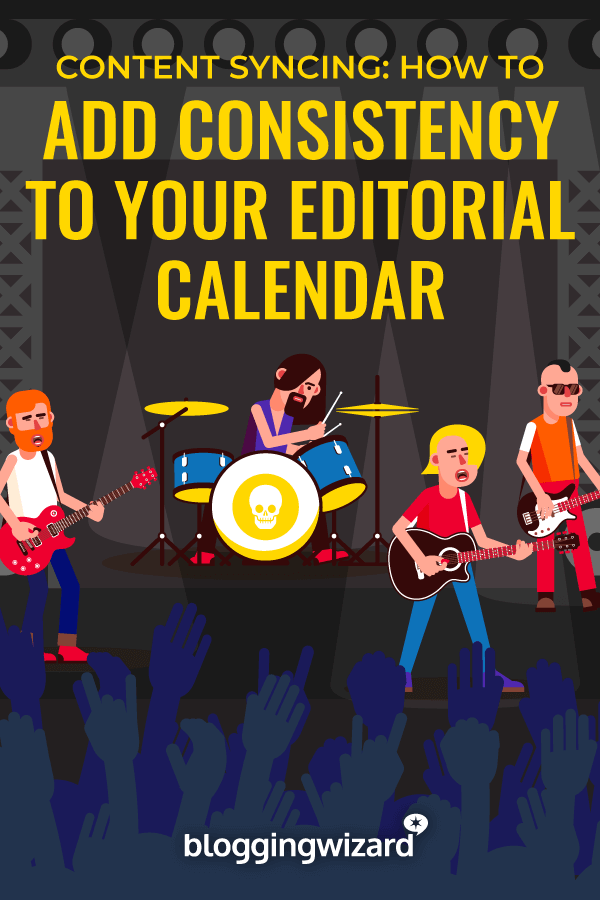Adding Consistency To Your Editorial Calendar By Syncing Your Content

Do you have a blog? Podcast? YouTube channel? Do you publish your content to multiple platforms?
Managing your editorial calendar for every type of content you create can be overwhelming. Fortunately, there are a few things you can do to make this process much easier on yourself.
In this post, we cover the benefits of consistency and how it can transform the way you manage all of the platforms you publish content to.
Note: Want our latest content delivered to your inbox? Click here to subscribe to the free Blogging Wizard newsletter.
The three most significant forms of content

Written content has existed for multiple millenia. When the video camera and radio were invented around the turn of the 19th century into the 20th, video and audio quickly became significant players as well.
Furthermore, plays, musical concerts, religious sermons and speaking conferences have captivated audiences for millenia, long before the days of newspaper, radio shows and television programs.
In the digital era, newspapers and magazines are now media sites and blogs. Radio shows are podcasts, and while TV and movies still dominate the video industry, there are now platforms like YouTube, Instagram, Facebook and TikTok small creators can publish to.
No matter what century it is, make no mistake about what the most significant forms of content are and which ones you should invest in: written, audio and video.
As such, blog posts, podcasts and videos published to common social media sites have become the most effective forms of content marketing, and the ones most capable of helping you achieve your goals.
Even so, there are wrong ways to approach these forms of content, and that’s what we want to address in this post.
How not to approach multi-platform content marketing
Many brands approach multi-platform content marketing in one of two ways. The first is posting the same content to every platform. With this method, the brand will likely publish a blog post, then use the text of that post as a script for a video. They’ll then publish that video to YouTube, Facebook and Instagram.
The main reason this method can be ineffective is the lack of variety across each platform. Your readers may also subscribe to you on YouTube and follow you on Instagram.
If they see your video on YouTube, they aren’t likely to read the blog post version when you promote it through social media or your email list, and vice versa. This will lead to fewer views and page visits, which will then lead to fewer shares.
The second reason this method is an issue is the same reason the second method is an issue, and that method is posting varied yet generic content to every platform.
Every type of content has its strengths and weaknesses, and every platform has its own needs in terms of optimization. You can’t expect a blog post you publish on your blog to perform the same way on Medium. You also shouldn’t expect a viral, one-minute TikTok clip to be a hit on Instagram.
If you’re going to create different types of content for your brand, do it right. Read a variety of different blogs, subscribe to different YouTube channels and listen to a few podcasts. Study them, learn why these particular creators are popular, and pinpoint what you like and don’t like about their content.
This research will help you plan and create better, more optimized content going forward. We’re going to hone in on the planning aspect of this for now.
What is content syncing?
Though not an official term for the practice, content syncing is a content marketing strategy where you cover the same topic across every platform you publish to at relatively the same time.
It sounds complicated when explained in this manner, so let’s use an example instead.
Let’s say you own a vegan food blog, but you also host a podcast and upload videos to YouTube. You want to cover meat substitutes on your blog, we’ll say something along the lines of an ultimate guide that teaches new vegans everything they need to know about replacing meat in their diets.

There’s nothing wrong with publishing whatever ideas you want to each platform, but you can truly drive up engagement across all platforms and grow your audience as a whole by implementing consistency in your content.
So, instead of publishing a single post about meat substitutes on your blog, drive up anticipation and engagement by dedicating an entire week or month to the topic. Publish that ultimate guide on your blog on Monday. Follow that up on Wednesday with a YouTube video on the best recipes to make with meat substitutes. Then, release a new episode of your podcast on Friday that features an interview with the founder of a meat substitute brand.
The variety gives your audience a reason to engage with your content.
How to include content syncing in your content marketing strategy
You don’t need to completely reinvent the way you plan your editorial calendar in order to implement content. You just need to pinpoint a select number of topics to cover, come up with multiple ideas for those topics and coordinate those ideas across all of the platforms you publish content to.
You can do this by following a few simple steps:
- Identify audience pain points.
- Come up with solutions for those pain points, then turn them into topic ideas.
- Come up with content ideas for those topics, and optimize them for the platforms you publish to.
We’ll start at the top.
Identifying audience pain points
Your first step should be to determine what topics to cover by identifying the topics your audience cares about the most. There are a few different ways you can do this.
The most effective thing you can do is to ask your audience directly about what they’re struggling with in your niche. Send a brief broadcast email about something you’ve struggled with in the past and conclude with a simple question:
“What is your biggest problem at the moment?”
You can also ask your most engaged viewers if they’d be willing to speak with you one on one, or simply reach out to them via direct message.
The responses you receive will help you determine which topics to focus on the most.
A few additional methods for finding audience pain points include jotting down questions and concerns your audience shares with you on a regular basis, browsing forums related to your niche, reading bad reviews for products in your niche and seeing which topics are most popular through keyword research.
Turning solutions into topic ideas
So, what you should have by the end of the previous step is a list of problems your audience or target audience is currently facing. Your next step is to turn that list of problems into a list of topic ideas. This isn’t hard to do at all when you break it down into steps.
Start by grouping your list of problems into three categories:
- Urgent – Problems you feel your audience needs solved as soon as possible
- Popular – Problems your audience spoke of the most but don’t necessarily need to be treated with the same level of urgency
- Less relevant – Problems that aren’t urgent nor popular
Focus on the Urgent list first. Rearrange the problems within the list based on what you feel needs to be tackled first. Write down solutions for each after that, then jot down the list of steps your reader will need to take to achieve that solution.
Those individual steps are where your topic ideas should come from. For example, replacing meat in a vegan’s diet requires learning about the role protein, vitamin D and vitamin B12 play in the human diet, becoming better informed about the ingredients used in meat substitutes and learning how to use substitutes in recipes that normally call for meat. All of these are great topic ideas.
Come up with topic ideas for your own steps, or turn each step into a topic idea.
Optimizing content ideas for multiple platforms
Once you have a list of content ideas to work with, your next step is to determine how to work them into your normal editorial calendar and overall content marketing strategy.
This will look different depending on the publication schedules you use for each platform. Some of you publish one blog post, one YouTube video and one podcast episode a week. Some of you publish a handful of times a month while others publish multiple times a week.
It’s just a matter of determining which topic ideas would work best for each platform after that. You can also tweak topic ideas to better fit a certain content type. In our earlier example, the interview podcast episode with a meat substitute brand would more than likely perform better than an episode dedicated to the best meat substitute recipes.
Consider each platform and content type’s strengths and weaknesses as well. For example, in-depth blog posts of 2,000 words and more perform well whereas shorter content of 15 minutes or less performs better on YouTube.
Final thoughts
Adding consistency to your content marketing strategy is a great way to boost engagement on every platform you use and a better way to establish yourself as an authority in your niche.
As a final note, don’t be afraid to stray from your editorial calendar every once in a while by uploading posts that may not fit into the current topic you’re focusing on.
These topics include reviews, especially for companies running time-sensitive promotions your readers would likely be interested in. They also include interviews, behind the scenes content, announcements and industry news.
This content marketing strategy is designed to help you fill the bulk of your editorial calendar and achieve your goals more efficiently. Nevertheless, it’s important that you don’t follow it too strictly to the point where you pass on topic ideas that may perform better for you.
And, once you’ve planned out your editorial calendar, you’re going to need a plan for promotion. Check out our posts on social media calendar tools, blog post promotion and content distribution platforms to get started.

